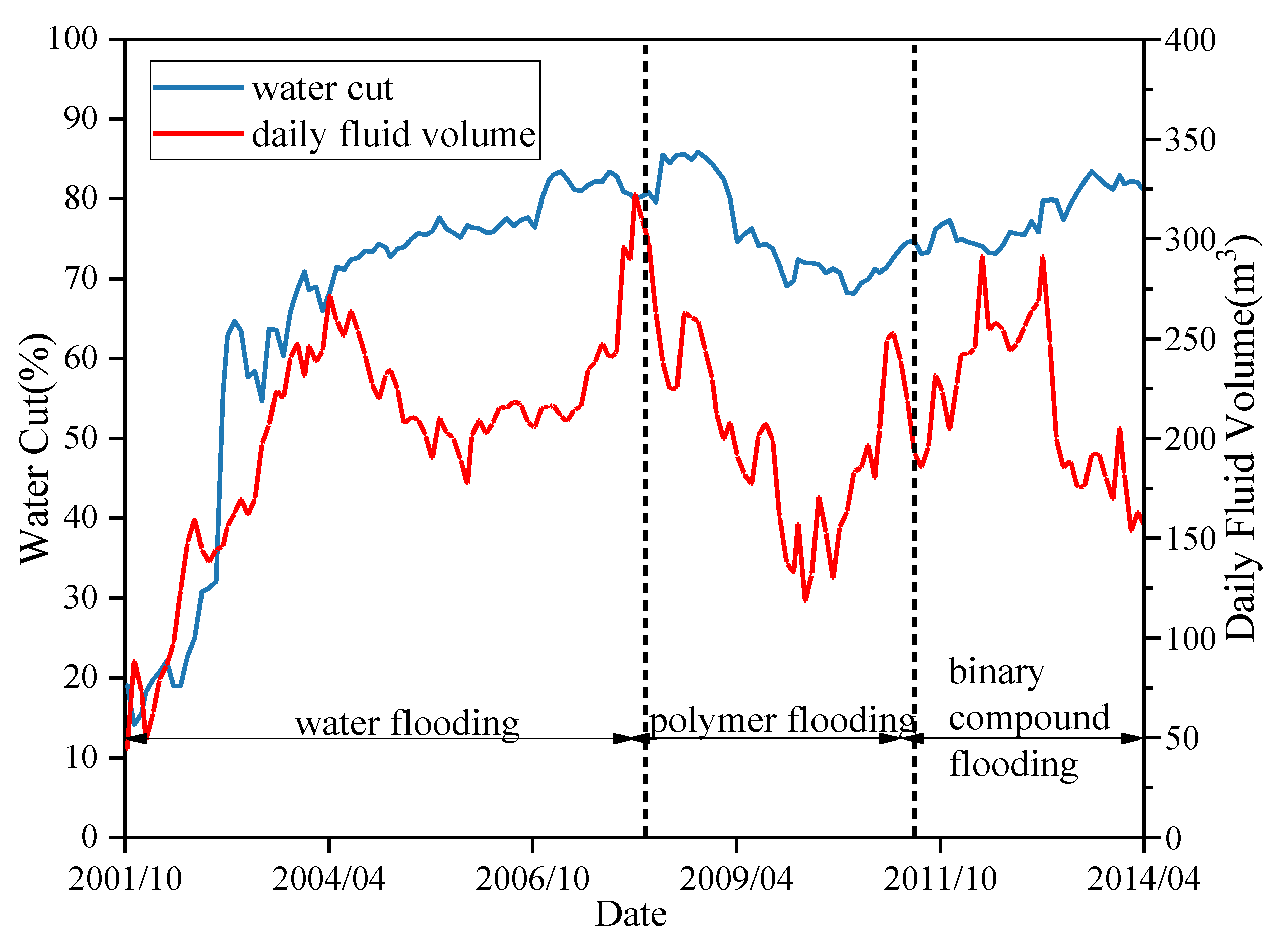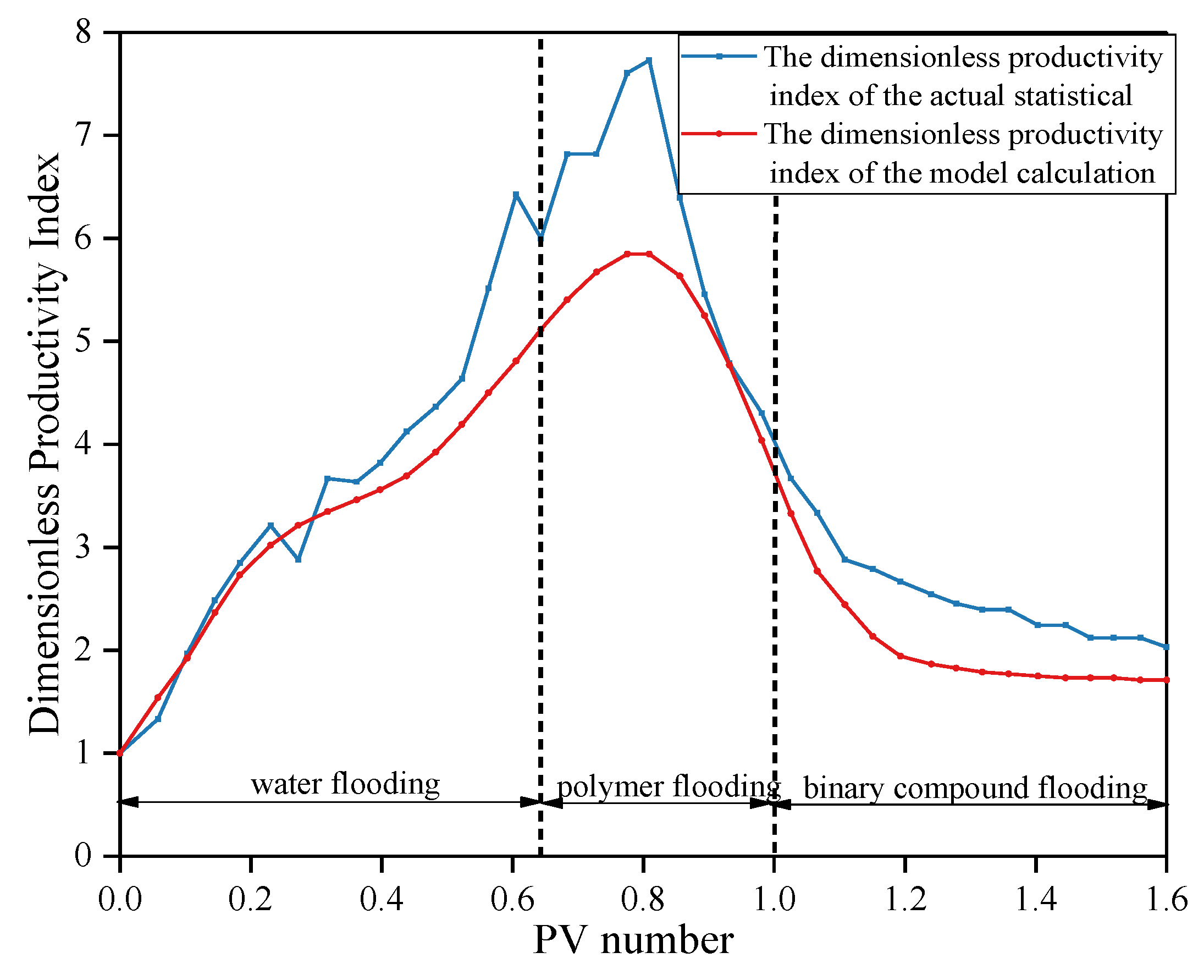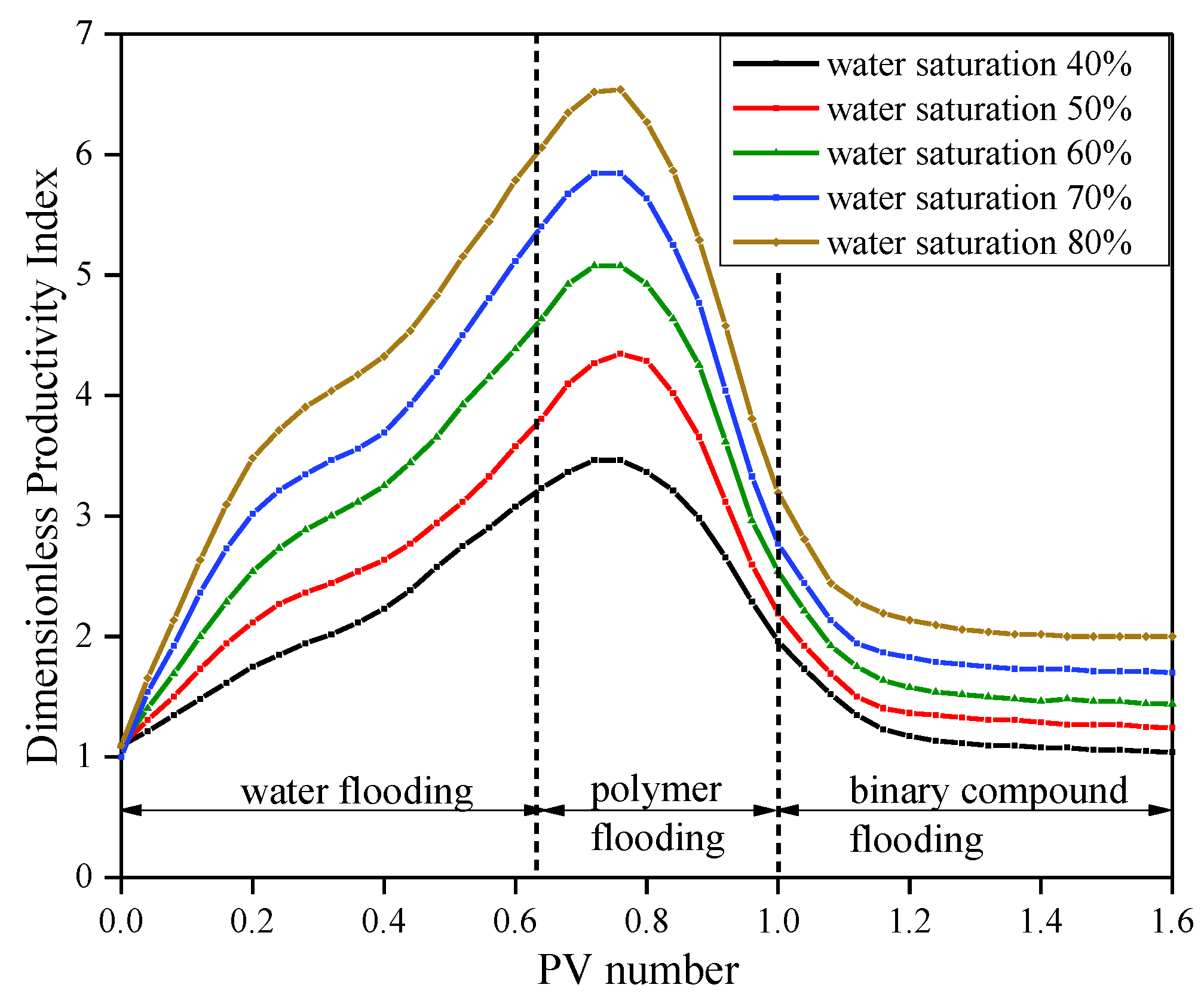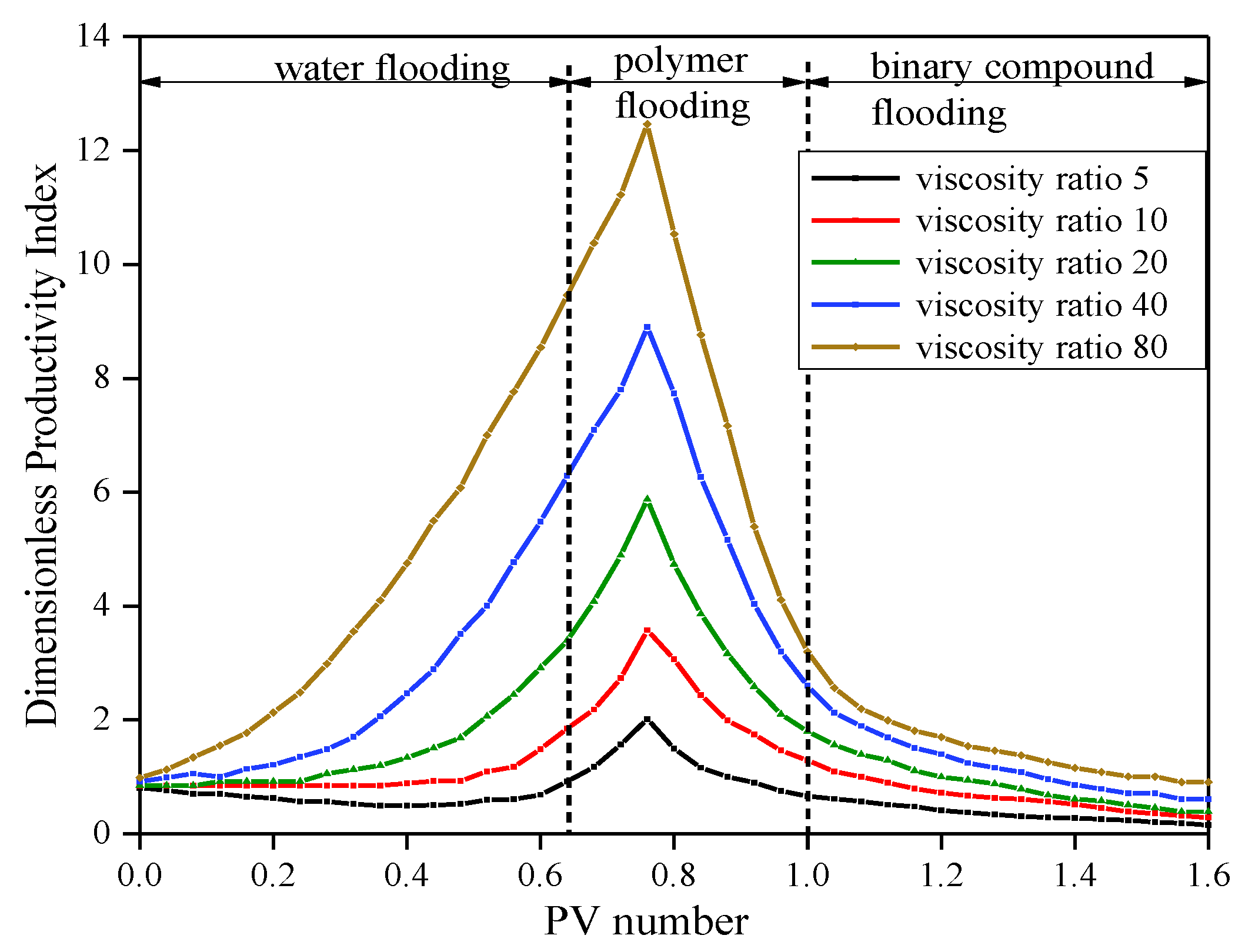A Calculation Model of the Dimensionless Productivity Index Based on Non-Piston Leading Edge Propulsion Theory in Multiple Oilfield Development Phases
Abstract
:1. Introduction
2. Establishment of a Calculation Model of the Dimensionless Productivity Index
2.1. Formula for Leading Edge Propulsion Distance
2.2. Calculation Formula of Water Flooding-Polymer Flooding-Binary Compound Flooding in Multi-Development Phases
2.2.1. Water Flooding Stage
2.2.2. Polymer Flooding Stage
2.2.3. Binary Compound Flooding Stage
3. Variation Rule of Dimensionless Productivity Index: Case Study of Block W of JZ9-3 Oilfield
3.1. Oilfield Overview
3.2. Comparative Analysis of the Dimensionless Productivity Index
3.3. Factors Affecting of the Dimensionless Producyivity Index
3.3.1. Water Saturation
3.3.2. Water–Oil Viscosity Ratio
4. Conclusions
- In this study, we established a calculation model of the dimensionless productivity index suitable for the multiple development phases of oilfields, including water flooding, polymer flooding, and binary compound flooding, and we established an index suitable for medium and low permeability reservoirs. The calculation results of the dimensionless productivity index model were compared with the actual statistical results; the calculation error rate of the dimensionless productivity index for the three oilfield development phases were 4.67%, 17.65%, and 18.50%, respectively. The average error rate was 10.38% in the overall development phase.
- In the development processes of water flooding, polymer flooding, and binary compound flooding, the dimensionless productivity index shows a trend of first rising, then falling, and finally stabilizing with the increase in PV injection. Before the effects of polymer injection occur, the dimensionless productivity index increased steadily and the increase rate was 71.75% monthly, and the oil displacement effect of the reservoir worsened. After the polymer injection became effective, the dimensionless productivity index steadily decreased, the decrease rate was 52.63% monthly, and the effect of oil displacement of the reservoir improved. After injection into the binary compound system, the dimensionless productivity index further decreased at a rate of 41.65% monthly, and the oil displacement effect of the reservoir was further improved. The method can be used to evaluate the law of the production fluid of the oil well after the polymer injection and binary compound injection.
- Under constant pressure conditions, the dimensionless productivity index is positively and linearly related with water saturation; under the same PV number, the dimensionless productivity index was larger, and the water saturation was higher. The change in the dimensionless productivity index was more drastic. During the stages of water flooding, ineffective polymer flooding, effective polymer flooding, and binary compound flooding, the average increase, and decrease ranges of the dimensionless productivity index were 71.42%, 6.24%, −63.64%, and −42.31%, respectively.
- Under constant pressure conditions, the dimensionless productivity index has a positively correlated linear relationship with the water–oil viscosity ratio; under the same PV number, the dimensionless productivity index was larger, and the water–oil viscosity ratio was higher. In the stages of water flooding, ineffective polymer flooding, effective polymer flooding, and binary compound flooding, the average increases and decreases of the dimensionless productivity index were 54.27%, 42.31%, −55.34%, and −65.20%, respectively.
Author Contributions
Funding
Conflicts of Interest
References
- Chen, F.; Zhang, L. Variation and Analysis of Liquid Production Index During Polymer Flooding. J. Pet. Geol. Oilfield Dev. Daqing 1996, 1, 44–46. [Google Scholar]
- Diyashev, I.R.; Economides, M.J. A General Approach to Well Evaluation. Soc. Pet. Eng. 2005. [Google Scholar] [CrossRef]
- Retnanto, A.; Economides, M.J. Inflow Performance Relationships of Horizontal and Multibranched Wells in a Solution-Gas-Drive Reservoir. Soc. Pet. Eng. 1998. [Google Scholar] [CrossRef]
- Yu, Q.; Luo, H.; Chen, S. A general formula for calculating dimensionless fluid production index in deltaic reservoir. J. China Offshore Oil Gas 2000, 4, 53–56. [Google Scholar]
- Perna, M.; Bartolotto, G.; Latronico, R.; Sghair, R.F. Dynamic Surveillance Templates for Reservoir Management: Diagnostic Tools Oriented to Production Optimization. Int. Pet. Technol. Conf. 2009. [Google Scholar] [CrossRef]
- Li, L.; Song, K.; Li, G.; Wang, P. Water Flooding Behavior of High Water-Cut Oilfield. J. Pet. Drill. Tech. 2009, 37, 91–94. [Google Scholar]
- Ramirez-Garnica, M.; Cazarez-Candia, O.; Mamora, D. Experimental Studies of Hydrocarbon Yields under Dry-, Steam-, and Steam-Propane Distillation. Pet. Soc. Can. 2006. [Google Scholar] [CrossRef]
- Guo, M. The Studies on Liquid Production of Subsequent Water Flooding of Polymer Flooding D; College of Petroleum Engineering China University of Petroleum (EastChina): Qing Dao, China, 2011. [Google Scholar]
- Yang, R.; Zhang, J.; Yang, L.; Jiang, R. A New Model for Predicting Productivity Index Pending Water Breakthrough in Oil Field. Soc. Pet. Eng. 2015. [Google Scholar] [CrossRef]
- Sandeep, P.K.; Vaz, R.F.; Gildin, E. Dimensionless Productivity Index and Its Derivative—Insights into Connectivity and Conductivity Variations of Fractures During Flowback in Unconventional Reservoirs. Soc. Pet. Eng. 2017. [Google Scholar] [CrossRef]
- Foxenberg, W.E.; Ali, S.A.; Ke, M.; Shelby, D.C.; Burman, J.W. Eliminate Formation Damage Caused by High Density Completion Fluid-Crude Oil Emulsion. Soc. Pet. Eng. 1998. [Google Scholar] [CrossRef]
- Lin, J.; Li, Z.; Zhang, Q. Study on Liquid Production Index Predietion for Different Water Cut. J. Pet. Drill. Tech. 2003, 31, 43–45. [Google Scholar]
- Poe, B.D.; Marique, J. Production Performance Design Criteria for Hydraulic Fractures (Russian). Soc. Pet. Eng. 2006. [Google Scholar] [CrossRef]
- Zhu, D.; Magalhaes, F.V.; Valko, P. Predicting the Productivity of Multiple-Fractured Horizontal Gas Wells. Soc. Pet. Eng. 2007. [Google Scholar] [CrossRef]
- Medeiros, F.; Kurtoglu, B.; Ozkan, E.; Kazemi, H. Analysis of Production Data from Hydraulically Fractured Horizontal Wells in Shale Reservoirs. Soc. Pet. Eng. 2010. [Google Scholar] [CrossRef]
- Li, K.; Chen, Z. Computation of Productivity Index with Capillary Pressure Included and Its Application in Interpreting Production Data from Low-permeability Oil Reservoirs. Soc. Pet. Eng. 2011. [Google Scholar] [CrossRef]
- Gu, J.W.; Yu, H.J.; Peng, S.S. Production Features in Complex Low Permeability Reservoir. J. Coll. Pet. Eng. Univ. Pet. 2003, 27, 55–57. [Google Scholar]
- Gu, J.; Kong, L.; Liu, Z.; Wei, M. Dimensionless Fluid Productivity Index Calculation Considering Fluid Distribution Difference. J. Spec. Oil Gas Reserv. 2015, 22, 78–80. [Google Scholar]
- Michail Papoutsidakis. ISS Stability Control: A Comparison of Different Approaches. Int. J. Eng. Appl. Sci. Technol. 2017, 2, 1–8. [Google Scholar]
- Wei, Z.J.; Chen, G.Z. Variation Law of Normalized Liquid Productivity Index during Chemical Flooding in J Oilfield of Bohai Bay. J. Chongqing Univ. Sci. Technol. 2019, 21, 55–58. [Google Scholar]
- Buckley, S.E.; Leverett, M.C. Mechanism of Fluid Displacement in Sands. Soc. Pet. Eng. 1942. [Google Scholar] [CrossRef]
- Welge, H.J. A Simplified Method for Computing Oil Recovery by Gas or Water Drive. Soc. Pet. Eng. 1952. [Google Scholar] [CrossRef]





| Parameter | Value |
|---|---|
| Porosity (%) | 0.29 |
| Well spacing (m) | 350 |
| Permeability (μm2) | 1.50 |
| Capillary pressure (Pa) | 0.20 |
| Formation pressure (MPa) | 16.43 |
| Water injection pore volume multiple (PV) | 0.64 |
| Polycondensation pore volume multiple (PV) | 1.00 |
| Note binary pore volume multiple (PV) | 1.60 |
| Ground water viscosity (mPa·s) | 0.80 |
| Underground crude oil viscosity (mPa·s) | 7.00 |
| Polymer viscosity (mPa·s) | 9.89 |
| Polymer–surfactant binary compound viscosity (mPa·s) | 12.40 |
© 2019 by the authors. Licensee MDPI, Basel, Switzerland. This article is an open access article distributed under the terms and conditions of the Creative Commons Attribution (CC BY) license (http://creativecommons.org/licenses/by/4.0/).
Share and Cite
Huang, B.; Liang, Q.; Fu, C.; He, C.; Song, K.; Liu, J. A Calculation Model of the Dimensionless Productivity Index Based on Non-Piston Leading Edge Propulsion Theory in Multiple Oilfield Development Phases. Processes 2019, 7, 821. https://doi.org/10.3390/pr7110821
Huang B, Liang Q, Fu C, He C, Song K, Liu J. A Calculation Model of the Dimensionless Productivity Index Based on Non-Piston Leading Edge Propulsion Theory in Multiple Oilfield Development Phases. Processes. 2019; 7(11):821. https://doi.org/10.3390/pr7110821
Chicago/Turabian StyleHuang, Bin, Qiaoyue Liang, Cheng Fu, Chunbai He, Kaoping Song, and Jinzi Liu. 2019. "A Calculation Model of the Dimensionless Productivity Index Based on Non-Piston Leading Edge Propulsion Theory in Multiple Oilfield Development Phases" Processes 7, no. 11: 821. https://doi.org/10.3390/pr7110821
APA StyleHuang, B., Liang, Q., Fu, C., He, C., Song, K., & Liu, J. (2019). A Calculation Model of the Dimensionless Productivity Index Based on Non-Piston Leading Edge Propulsion Theory in Multiple Oilfield Development Phases. Processes, 7(11), 821. https://doi.org/10.3390/pr7110821




